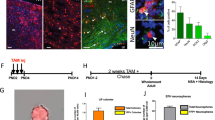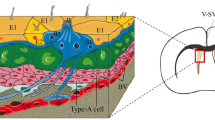Abstract
In many animal species, the production of new neurons (neurogenesis) occurs throughout life, in a specialized germinal region called the ventricular–subventricular zone (V-SVZ). In this region, neural stem cells undergo self-renewal and generate neural progenitor cells and new neurons. In the olfactory system, the new neurons migrate rostrally toward the olfactory bulb, where they differentiate into mature interneurons. V-SVZ-derived new neurons can also migrate toward sites of brain injury, where they contribute to neural regeneration. Recent studies indicate that two major branches of the Wnt signaling pathway, the Wnt/β-catenin and Wnt/planar cell polarity pathways, play essential roles in various facets of adult neurogenesis. Here, we review the Wnt signaling-mediated regulation of adult neurogenesis in the V-SVZ under physiological and pathological conditions.




Similar content being viewed by others
Abbreviations
- APC:
-
Adenomatous polyposis coli
- Celsr:
-
Cadherin EGF LAG seven-pass G-type receptor
- CNS:
-
Central nervous system
- CSF:
-
Cerebrospinal fluid
- DAPI:
-
4′,6-Diamidino-2-phenylindole
- DKK:
-
Dickkopf
- Dvl:
-
Dishevelled
- Fzd:
-
Frizzled
- GSK3β:
-
Glycogen synthase kinase 3β
- Hipk1:
-
Homeodomain-interacting protein kinase-1
- JNK:
-
c-Jun N-terminal kinase
- LEF:
-
Lymphoid enhancer binding factor
- NPC:
-
Neural progenitor cell
- NSC:
-
Neural stem cell
- OB:
-
Olfactory bulb
- OPC:
-
Oligodendrocyte progenitor cell
- PCP:
-
Planar cell polarity
- RMS:
-
Rostral migratory stream
- SGZ:
-
Subgranular zone
- TCF:
-
T cell transcription factor
- TLX:
-
Tailless
- Vangl2:
-
Van Gogh like-2
- V-SVZ:
-
Ventricular–subventricular zone
- WIP1:
-
Wild-type p53-induced phosphatase 1
References
Fuentealba LC, Obernier K, Alvarez-Buylla A (2012) Adult neural stem cells bridge their niche. Cell Stem Cell 10(6):698–708. doi:10.1016/j.stem.2012.05.012
Gage FH (2000) Mammalian neural stem cells. Science 287(5457):1433–1438
Lledo PM, Alonso M, Grubb MS (2006) Adult neurogenesis and functional plasticity in neuronal circuits. Nat Rev Neurosci 7(3):179–193. doi:10.1038/nrn1867
Ming GL, Song H (2005) Adult neurogenesis in the mammalian central nervous system. Annu Rev Neurosci. doi:10.1146/annurev.neuro.28.051804.101459
Zhao C, Deng W, Gage FH (2008) Mechanisms and functional implications of adult neurogenesis. Cell 132(4):645–660. doi:10.1016/j.cell.2008.01.033
Kokovay E, Wang Y, Kusek G et al (2012) VCAM1 is essential to maintain the structure of the SVZ niche and acts as an environmental sensor to regulate SVZ lineage progression. Cell Stem Cell 11(2):220–230. doi:10.1016/j.stem.2012.06.016
Mirzadeh Z, Merkle FT, Soriano-Navarro M et al (2008) Neural stem cells confer unique pinwheel architecture to the ventricular surface in neurogenic regions of the adult brain. Cell Stem Cell 3(3):265–278. doi:10.1016/j.stem.2008.07.004
Doetsch F, Caille I, Lim DA et al (1999) Subventricular zone astrocytes are neural stem cells in the adult mammalian brain. Cell 97(6):703–716
Ponti G, Obernier K, Guinto C et al (2013) Cell cycle and lineage progression of neural progenitors in the ventricular–subventricular zones of adult mice. Proc Natl Acad Sci USA 110(11):E1045–E1054. doi:10.1073/pnas.1219563110
Lois C, Alvarez-Buylla A (1994) Long-distance neuronal migration in the adult mammalian brain. Science 264(5162):1145–1148
Luskin MB (1993) Restricted proliferation and migration of postnatally generated neurons derived from the forebrain subventricular zone. Neuron 11(1):173–189. doi:10.1016/0896-6273(93)90281-U
Arvidsson A, Collin T, Kirik D et al (2002) Neuronal replacement from endogenous precursors in the adult brain after stroke. Nat Med 8(9):963–970. doi:10.1038/nm747
Kojima T, Hirota Y, Ema M et al (2010) Subventricular zone-derived neural progenitor cells migrate along a blood vessel scaffold toward the post-stroke striatum. Stem Cells 28(3):545–554. doi:10.1002/stem.306
Ohab JJ, Fleming S, Blesch A, Carmichael ST (2006) A neurovascular niche for neurogenesis after stroke. J Neurosci 26(50):13007–13016. doi:10.1523/JNEUROSCI.4323-06.2006
Parent JM, Vexler ZS, Gong C et al (2002) Rat forebrain neurogenesis and striatal neuron replacement after focal stroke. Ann Neurol 52(6):802–813. doi:10.1002/ana.10393
Thored P, Arvidsson A, Cacci E et al (2006) Persistent production of neurons from adult brain stem cells during recovery after stroke. Stem Cells 24(3):739–747. doi:10.1634/stemcells.2005-0281
Yamashita T, Ninomiya M, Hernandez Acosta P et al (2006) Subventricular zone-derived neuroblasts migrate and differentiate into mature neurons in the post-stroke adult striatum. J Neurosci 26(24):6627–6636. doi:10.1523/JNEUROSCI.0149-06.2006
Greenberg DA, Jin K (2005) From angiogenesis to neuropathology. Nature 438(7070):954–959. doi:10.1038/nature04481
Kaneko N, Sawamoto K (2009) Adult neurogenesis and its alteration under pathological conditions. Neurosci Res 63(3):155–164. doi:10.1016/j.neures.2008.12.001
Massouh M, Saghatelyan A (2010) De-routing neuronal precursors in the adult brain to sites of injury: role of the vasculature. Neuropharmacology 58(6):877–883. doi:10.1016/j.neuropharm.2009.12.021
Sawada M, Sawamoto K (2013) Mechanisms of neurogenesis in the normal and injured adult brain. Keio J Med 62(1):13–28
Patapoutian A, Reichardt LF (2000) Roles of Wnt proteins in neural development and maintenance. Curr Opin Neurobiol 10(3):392–399
Inestrosa NC, Arenas E (2010) Emerging roles of Wnts in the adult nervous system. Nat Rev Neurosci 11(2):77–86. doi:10.1038/nrn2755
Devenport D (2014) The cell biology of planar cell polarity. J Cell Biol 207(2):171–179. doi:10.1083/jcb.201408039
Tissir F, Goffinet AM (2013) Shaping the nervous system: role of the core planar cell polarity genes. Nat Rev Neurosci 14(8):525–535. doi:10.1038/nrn3525
Adachi K, Mirzadeh Z, Sakaguchi M et al (2007) Beta-catenin signaling promotes proliferation of progenitor cells in the adult mouse subventricular zone. Stem Cells 25(11):2827–2836. doi:10.1634/stemcells.2007-0177
Azim K, Fischer B, Hurtado-Chong A et al (2014) Persistent Wnt/beta-catenin signaling determines dorsalization of the postnatal subventricular zone and neural stem cell specification into oligodendrocytes and glutamatergic neurons. Stem Cells 32(5):1301–1312. doi:10.1002/stem.1639
Marinaro C, Pannese M, Weinandy F et al (2012) Wnt signaling has opposing roles in the developing and the adult brain that are modulated by Hipk1. Cereb Cortex 22(10):2415–2427. doi:10.1093/cercor/bhr320
Piccin D, Morshead CM (2011) Wnt signaling regulates symmetry of division of neural stem cells in the adult brain and in response to injury. Stem Cells 29(3):528–538. doi:10.1002/stem.589
Zhu Y, Demidov ON, Goh AM et al (2014) Phosphatase WIP1 regulates adult neurogenesis and WNT signaling during aging. J Clin Invest 124(7):3263–3273. doi:10.1172/JCI73015
Azim K, Rivera A, Raineteau O, Butt AM (2014) GSK3beta regulates oligodendrogenesis in the dorsal microdomain of the subventricular zone via Wnt-beta-catenin signaling. Glia 62(5):778–779. doi:10.1002/glia.22641
Yu JM, Kim JH, Song GS, Jung JS (2006) Increase in proliferation and differentiation of neural progenitor cells isolated from postnatal and adult mice brain by Wnt-3a and Wnt-5a. Mol Cell Biochem 288(1–2):17–28. doi:10.1007/s11010-005-9113-3
Qu Q, Sun G, Li W et al (2010) Orphan nuclear receptor TLX activates Wnt/beta-catenin signalling to stimulate neural stem cell proliferation and self-renewal. Nat Cell Biol 12(1):31–40. doi:10.1038/ncb2001 (sup pp 31–39)
Ortega F, Gascon S, Masserdotti G et al (2013) Oligodendrogliogenic and neurogenic adult subependymal zone neural stem cells constitute distinct lineages and exhibit differential responsiveness to Wnt signalling. Nat Cell Biol 15(6):602–613. doi:10.1038/ncb2736
Imura T, Wang X, Noda T et al (2010) Adenomatous polyposis coli is essential for both neuronal differentiation and maintenance of adult neural stem cells in subventricular zone and hippocampus. Stem Cells 28(11):2053–2064. doi:10.1002/stem.524
Schwarz-Romond T, Asbrand C, Bakkers J et al (2002) The ankyrin repeat protein Diversin recruits Casein kinase Iepsilon to the beta-catenin degradation complex and acts in both canonical Wnt and Wnt/JNK signaling. Genes Dev 16(16):2073–2084. doi:10.1101/gad.230402
van Amerongen R, Nawijn MC, Lambooij JP et al (2010) Frat oncoproteins act at the crossroad of canonical and noncanonical Wnt-signaling pathways. Oncogene 29(1):93–104. doi:10.1038/onc.2009.310
Ikeda M, Hirota Y, Sakaguchi M et al (2010) Expression and proliferation-promoting role of Diversin in the neuronally committed precursor cells migrating in the adult mouse brain. Stem Cells 28(11):2017–2026. doi:10.1002/stem.516
Hirota Y, Sawada M, Kida YS et al (2012) Roles of planar cell polarity signaling in maturation of neuronal precursor cells in the postnatal mouse olfactory bulb. Stem Cells 30(8):1726–1733. doi:10.1002/stem.1137
Pino D, Choe Y, Pleasure SJ (2011) Wnt5a controls neurite development in olfactory bulb interneurons. ASN Neuro 3(3):e00059. doi:10.1042/AN20100038
Sawamoto K, Wichterle H, Gonzalez-Perez O et al (2006) New neurons follow the flow of cerebrospinal fluid in the adult brain. Science 311(5761):629–632. doi:10.1126/science.1119133
Mirzadeh Z, Han YG, Soriano-Navarro M et al (2010) Cilia organize ependymal planar polarity. J Neurosci 30(7):2600–2610. doi:10.1523/JNEUROSCI.3744-09.2010
Hirota Y, Meunier A, Huang S et al (2010) Planar polarity of multiciliated ependymal cells involves the anterior migration of basal bodies regulated by non-muscle myosin II. Development 137(18):3037–3046. doi:10.1242/dev.050120
Kubo A, Yuba-Kubo A, Tsukita S et al (2008) Sentan: a novel specific component of the apical structure of vertebrate motile cilia. Mol Biol Cell 19(12):5338–5346. doi:10.1091/mbc.E08-07-0691
Guirao B, Meunier A, Mortaud S et al (2010) Coupling between hydrodynamic forces and planar cell polarity orients mammalian motile cilia. Nat Cell Biol 12(4):341–350. doi:10.1038/ncb2040
Ohata S, Herranz-Pérez V, Nakatani J et al (2015) Mechanosensory genes Pkd1 and Pkd2 contribute to the planar polarization of brain ventricular epithelium. J Neurosci 35(31):11153–11168. doi:10.1523/JNEUROSCI.0686-15.2015
Ohata S, Nakatani J, Herranz-Perez V et al (2014) Loss of Dishevelleds disrupts planar polarity in ependymal motile cilia and results in hydrocephalus. Neuron 83(3):558–571. doi:10.1016/j.neuron.2014.06.022
Boutin C, Labedan P, Dimidschstein J et al (2014) A dual role for planar cell polarity genes in ciliated cells. Proc Natl Acad Sci USA 111(30):E3129–E3138. doi:10.1073/pnas.1404988111
Tissir F, Qu Y, Montcouquiol M et al (2010) Lack of cadherins Celsr2 and Celsr3 impairs ependymal ciliogenesis, leading to fatal hydrocephalus. Nat Neurosci 13(6):700–707. doi:10.1038/nn.2555
Lei ZN, Zhang LM, Sun FY (2008) Beta-catenin siRNA inhibits ischemia-induced striatal neurogenesis in adult rat brain following a transient middle cerebral artery occlusion. Neurosci Lett 435(2):108–112. doi:10.1016/j.neulet.2008.02.031
Zhang RL, LeTourneau Y, Gregg SR et al (2007) Neuroblast division during migration toward the ischemic striatum: a study of dynamic migratory and proliferative characteristics of neuroblasts from the subventricular zone. J Neurosci 27(12):3157–3162. doi:10.1523/JNEUROSCI.4969-06.2007
Shruster A, Ben-Zur T, Melamed E, Offen D (2012) Wnt signaling enhances neurogenesis and improves neurological function after focal ischemic injury. PLoS ONE 7(7):e40843. doi:10.1371/journal.pone.0040843
L’Episcopo F, Tirolo C, Testa N et al (2013) Aging-induced Nrf2-ARE pathway disruption in the subventricular zone drives neurogenic impairment in parkinsonian mice via PI3 K-Wnt/beta-catenin dysregulation. J Neurosci 33(4):1462–1485. doi:10.1523/JNEUROSCI.3206-12.2013
L’Episcopo F, Tirolo C, Testa N et al (2012) Plasticity of subventricular zone neuroprogenitors in MPTP (1-methyl-4-phenyl-1,2,3,6-tetrahydropyridine) mouse model of Parkinson’s disease involves cross talk between inflammatory and Wnt/beta-catenin signaling pathways: functional consequences for neuroprotection and repair. J Neurosci 32(6):2062–2085. doi:10.1523/JNEUROSCI.5259-11.2012
Higginbotham H, Bielas S, Tanaka T, Gleeson JG (2004) Transgenic mouse line with green-fluorescent protein-labeled Centrin 2 allows visualization of the centrosome in living cells. Transgenic Res 13(2):155–164
Acknowledgments
We apologize to all whose work we could not cite because of space limitation. We thank Dr. Naoko Kaneko for critical reading of the manuscript, Dr. Kazuhide Adachi, Dr. Makiko Ikeda, and all our collaborators for their contributions to original research, and members of Sawamoto laboratory for discussions. This work was supported by JSPS KAKENHI Grant Numbers 26250019, 26640046, 22122004, 15H01217, 15H01384 (to K.S.), and 26830014 (to M.S.), the Takeda Science Foundation (to K.S., and M.S.), and the Terumo Life Science Foundation (to K.S.).
Author information
Authors and Affiliations
Corresponding author
Additional information
Yuki Hirota, Masato Sawada and Shih-hui Huang have contributed equally to this work.
Special Issue: 40th Year of Neurochemical Research.
Rights and permissions
About this article
Cite this article
Hirota, Y., Sawada, M., Huang, Sh. et al. Roles of Wnt Signaling in the Neurogenic Niche of the Adult Mouse Ventricular–Subventricular Zone. Neurochem Res 41, 222–230 (2016). https://doi.org/10.1007/s11064-015-1766-z
Received:
Revised:
Accepted:
Published:
Issue Date:
DOI: https://doi.org/10.1007/s11064-015-1766-z




